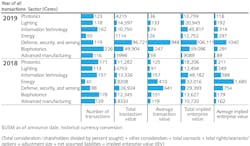Business Forum: 2019 mergers & acquisitions in photonics
In the worldwide photonics industry, 2019 was another record year for mergers & acquisitions (M&As) in terms of both deal value and deal volume (see figure). However, M&A activity for pure-play photonics companies was down from recent years. Strategic buyers continued to dominate M&A, but financial buyers took an increasing role.
In 2018, strategic buyers used M&As to address the challenges of slower growth, an abundance of investment capital, advances in digital and mobile technologies, and government intervention. These buyers were acquiring companies to open new markets, enhance capabilities, and implement new business models, but the acquisitions did not match the pace of 2019.
In 2019, we see more strategic buyers executing vertical integration plays. In the photonics industry and vertical markets employing photonics technologies, acquisitions made to enhance capabilities or secure a supply chain were predominantly made in lower-middle market companies with new technologies or innovative business models.
Although the majority of buyers were still strategic in 2019, there was a higher concentration of financial buyers than in the past. Because of the trade wars, strategic buyers of manufactured goods appear to be waiting out the uncertainty. Financial buyers appeared to be forging ahead, investing their abundance of dry-powder with the flexibility of investing for the long term that publicly traded strategic buyers do not enjoy.
Financial buyers appeared bullish on integration risk and were consequently scooping-up smaller add-on targets. The motivation was to average-down the recent relatively high buy-in multiples for their platform middle-market companies. This maps to a substantially larger M&A market for micro- and lower-middle market companies.
Strategic buyers—still the most active
Strategic buyers, compared to financial buyers, were still by far the most active—acquiring small- and middle-market photonics-enabled companies across a wide breadth of markets.
In 2019, the most active buyers by number of transactions were FLIR Systems, Signify, Thorlabs, and Zhejiang Yankon Group. FLIR Systems acquired Aria Insights and Aeryon Labs, providers of unmanned aerial systems and vehicles; New England Optical Systems, manufacturer of infrared optical assemblies; and Providence Photonics, developer of optical gas imaging software. Thorlabs acquired four micro-market companies with core photonics technology in x-ray metrology, Raman spectroscopy, and thin film coating. Signify and Zhejiang Yankon Group each acquired four LED lighting companies.
M&A for pure-play photonics companies
Pure-play photonics companies supply cameras, optics, light sources, materials, coatings, and software to a plethora of end markets. Strategic buyers continued to lead, but as with the M&A market as a whole, there was a higher concentration of financial buyers. Of the majority stake transactions reporting value, there were two targets—Samyang Optics Co., Ltd ($88 million) and Amplitude Laser Group SAS ($102 million) acquired by financial buyers.
In 2019, the largest announced strategic acquisition of 100% stake ($377 million) and one of the highest implied enterprise value/earnings before interest, taxes, depreciation, and amortization (IEV/EBITDA) valuation (13.3x) in photonics was the acquisition of First Sensor by TE Connectivity. The second largest strategic acquisition of 100% stake ($347 million) in photonics was the acquisition of Lite-On Semiconductor by Diodes Incorporated with one of the lowest IEV/EBITDA valuations (2.3x). Following is Repligen's acquisition of 100% stake in C Technologies, with one of the highest IEV/revenue valuations (9.6x).
M&A for companies with core photonics technology
Core photonics technology companies rely, at least in part, on photonics technology in their market sectors. Several sectors stood out in 2019:
Within the advanced manufacturing sector, the metrology market segment continued to see the most activity. The largest acquisition was Hitachi‘s $1.4 billion vertical acquisition of JP Automation Technologies, a provider of integrated advanced automation solutions that incorporate a wide range of optical inspection, sensing, and material processing capabilities. Likely due to waiting out uncertainty, activity within the additive manufacturing and laser material processing segments was the lowest of the decade for strategic buyers in the U.S.
Within information technology, the largest and highest priced acquisition was Cisco Systems’ $3.1 billion acquisition of Acacia Communications, a provider of coherent optical interconnects, at 98x IEV/EBITDA to enter the multi-billion-dollar, outside-the-datacenter networking market. Cisco Systems had acquired Luxtera in December 2018 to own the inside-the-datacenter optical networking market for $660 million.
The imaging and interface sector saw a large increase in activity in 2019. Strategic buyers acquired facial recognition technology, 3D imaging hardware, and software to develop augmented reality content, image analytics, and gesture recognition technology. Most acquisitions were vertical integration plays, including Huawei Technologies’ acquisition of Vocord Telecom‘s facial recognition intellectual property; Facebook‘s acquisition of GrokStyle, developer of AI-based machine vision retail applications; and Apple‘s acquisition of Spectral Edge for its image enhancement and multispectral vision technologies.
The M&A market in biophotonics was up from 2018 in terms of volume, but valuations for the statistically small samples were lower. The environmental segment saw the biggest jump in activity with targets supplying water, soil, gas, and air monitoring and treatment solutions. Technologies span spectroscopy to x-ray diffraction to gas imaging. The most active buyer was Pentair, which acquired UV water treatment solution suppliers Aquion and Enviro Water Solutions for $160 million and $120 million, respectively.
In the defense, security, and sensing sector, the high volume of M&A activity in the surveillance and navigation market segment was largely attributed to targets supplying imaging and sensing engines, software, and solutions for unmanned ground and aerial vehicles. Funded by its $530 million financing, Aurora Innovation acquired Blackmore Sensors and Analytics, frequency-modulated continuous-wave (FMCW) lidar and supporting analytic tools that measure radial velocity. Porsche Automobil Holding acquired AEVA, a lidar developer. Leica Geosystems Technology acquired Melown Technologies, a computer vision developer supplying 3D visualization of digital urban and natural landscape models. And FARO Technologies acquired Opto Tech, a manufacturer of 3D structured light scanning solutions, for $22 million.
Impact of CFIUS and FIRRMA
Geographically, the most significant trend over the previous five years has been an acceleration of cross-regional acquisitions. Prior to 2018, buyers were acquiring more targets in geographical areas outside their own. That trend lost its momentum in 2018, and fell off a cliff in 2019. The North American M&A activity involving Chinese buyers is on pace to fall by more than 90% from its 2016 peak.
U.S.-based companies and Chinese acquirers ceased doing business partially because of the trade war between the two countries. Strategic buyers of manufactured goods worldwide appeared to be waiting out the uncertainty, forcing financial buyers to hold investments otherwise ready for exit.
The bigger influence has been the Committee on Foreign Investment in the US (CFIUS). CFIUS has been effectively blocking transactions, mostly on national security grounds. Significant changes to the CFIUS review process expanded its jurisdiction to new types of transactions and changed the timeline and procedures for seeking approval for a transaction from CFIUS. The implications for photonics technology companies have been considerable.
The Foreign Investment Risk Review Modernization Act (FIRRMA), effective November 10, 2018, expanded CFIUS jurisdiction to non-controlling foreign investment into U.S. businesses in possession of “critical technologies.”
Twenty-seven industries were specifically identified where the threat of erosion of technological superiority from foreign direct investment requires immediate action, including the following relevant to photonics:
- Optical Instrument and Lens Manufacturing NAICS: 333314
- Other Guided Missile and Space Vehicle Parts and Auxiliary Equipment Manufacturing NAICS: 336419
- Research and Development in Nanotechnology NAICS: 541713
- Search, Detection, Navigation, Guidance, Aeronautical, and Nautical System and Instrument Manufacturing NAICS: 334511
- Semiconductor and Related Device Manufacturing NAICS: 334413
For photonics technology companies seeking growth capital, a buyer, or a partnership within the China supply chain, these significant changes have reduced the pool of opportunities or, at the very least, added substantial risk and complexity in closing a transaction with a foreign partner.
China strategic buyers are opting to put capital to work with European or Chinese photonics technology companies, while U.S. investment funds are being advised to review and revise agreements with non-controlling, foreign co-investors. This may discourage these U.S. investment funds from investing in photonics technology companies where it is unclear if the photonics technology will be deemed “critical technology.”
For the full article, please visit http://bit.ly/CeresFullArticle.
NOTE: Ceres Technology Advisors sources transaction data from public sources. Ceres analysis and data are subject to errors and omissions. Accuracy of information is the responsibility of user.
About the Author
Linda Smith
President, Ceres Technology Advisors
Linda Smith is a recognized leader in M&A advisory. Spanning the spectrum of photonics-enabled markets, she advised on acquisitions and financings valued at more than $1.5 billion. She founded CERES in 2005 to serve photonics companies underserved by generalist investment bankers. Prior, she held product management, engineering, and sales positions at public and private equity-financed photonics companies.

